Updated February 2025
You create an ad, spend money, and watch impressions go gangbusters.
But no one buys 🫤
What went wrong? Eeesh. Probably a lot 🫣
B2B ads are WILDLY different from B2C ads, but if you think B2B Google Ads is advertising in hard mode, you haven’t used it the right way.
Well, lucky day! 🍀
Here are 10 strategies for high-quality B2B leads that make you money.
TL;DR
Knowing the difference between B2B Google Ads and B2C Google Ads gets you thinking the right way—longer sales cycles, multiple decision makers, higher commitment, and bigger price tag.
These 10 strategies will get you the most out of B2B Google Ads: timeline, account structure, keyword research, single keyword ad groups (SKAGs), targeting, negative keywords, optimizing ad copy and landing pages, analytics, and retargeting.
This is how you compete with the big dawgs.
Get brand new Google ad strategies straight to your inbox every week. 23,739 people already are!
What is a B2B Google Ad?
Let’s start by defining B2B (business to business).
When one business (B) sells stuff to (2) another business (B), that’s a B2B transaction.
A B2B ad promotes products and services from one business to other businesses that benefit from those products and services.
This differs from B2C (business to consumer), where a business (B) sells products to (2) consumers (C).
Sephora is one example. Sephora sells a range of beauty products to thousands of people. Sephora’s B2C ads target those consumers by showing off different beauty products and promotions.
D2C (Direct to consumer) is different again, where a company sells directly (D) to (2) the consumer (C). In this case, Summer Fridays (one brand sold at Sephora) sells its products to consumers directly from the Summer Fridays website (but they also use Sephora to sell their products, too).
This article is for businesses selling to other businesses.
Let’s do that well and make lots of money 🤑
B2B Google Ads
B2B Google Ads are online advertisements that target businesses in the Googleverse (riding on Google’s search engine).
These ads use a pay-per-click (PPC) model, meaning you only pay when someone clicks your ad because it pops up in front of them at the search bar seconds after they enter a search query to find a solution for their company.
By golly, your company can help their company.
And now they’re clicking to find out more, and your conversion face is holding its breath.
B2B advertising vs B2C advertising
Strategy, ad copy, and keywords differ between B2B and B2C ads. Sales cycle, buyers, and commitment level differ, too.
Sales cycles
B2C sales happen in minutes: you see something you like online, and you buy it.
Not so with B2B.
The average sales cycle for B2B companies is approximately 2.1 months.

Buyers
B2C companies sell to one person. B2B companies sell to a buying committee with more than one decision-maker.
Commitment
Buying in B2C is spontaneous sometimes and pretty short the rest of the time.
Maybe someone waits 20 minutes before giving in to their desire for that $70 eyelash serum. But sooner rather than later, they place the order on their points card, grab two free samples, and take advantage of free shipping. Done.
B2B purchases are bigger than that.
They come with hefty price tags and long-term contracts. There’s more pressure behind the purchase—it’s a commitment that might sink a company if the purchase is the wrong one in hindsight.
Knowing this difference between B2B and B2C is the starting point for your Google Ads strategy.
How do I target B2B on Google Ads?
Targeting a B2B audience on Google Ads is easy once you understand
- How long it will take—B2B Google advertising is a long-haul thing
- Where to go
- How to talk to them
- What makes them act
The mindset needs to be that you're building a relationship with your audience. Relationships get better over time, and so will your results.
Ultimately, you're there to make them the hero. A hero to their department, their boss, or even the whole company. Pointing a spotlight on the value of your product or service is the first thing.
The B2B audience is always looking for information upon which to base their decision. Whether it’s thought leadership or features and benefits, ads that provide all the answers and show the ROI are the ones winning audiences.
That doesn’t mean B2B ads can’t take a page from the B2C advertising playbook, where ads often aim to entertain or stir emotions. Emotional triggers are the heart of any good story, and ads are the shortest stories. But B2B audiences feel the pressure to check justification boxes after you hook them with wit.
Simply put, a B2B audience is high maintenance—and they're worth it.
We'll get specific about how to target a B2B audience with Google Search Ads using strategies like negative keywords and retargeting.
Do B2B Google Ads work?
Done right, B2B Google Ads racks in ROI from brand awareness to lead generation to sales.
Consider this:
- Google owns approximately 90% of search engine market share worldwide
- Before interacting with a website, the average B2B buyer conducts 12 different online searches
There's no question that search is a vital part of B2B marketing. And there are only two ways to show up on the search engine:
- Organically, with a solid SEO strategy or
- Paid, using PPC campaigns
SEO works wonders when you do it right, but it takes a lot of time and effort to produce enough of the right content to show up where you need to be.
PPC is immediate.
With the right digital marketing strategy and the knowledge you’re learning here, PPC campaigns will bring your business an influx of leads and sales. Google Ads puts your business in front of your target audience at all stages of the funnel with targeted messaging that says exactly what they need to hear when they need to hear it.
Feeling hesitant?
Let's look at examples of how we used our own strategy for real accounts:
Finning
We helped Finning, a worldwide Caterpillar equipment dealer, increase their conversions by 86% while reducing their CPA by 24%. Want to know how we did it? Google Ads. On this one, we’ll shout out to Smart Bidding.
Juniper Networks
We helped Juniper Networks, a company that provides high-performance networking and cybersecurity solutions, lower their cost per lead by 86% while increasing conversion rates by 326%. Yeah, you read those numbers right. Want to know how we did it? Google Ads. The real MVP on this case studywas using negative keyword audiences.
Wunderkind
With Wunderkind (formerly BounceX), a SaaS technology built for performance marketers, we saw a 48% decrease in cost per demo and brought the conversion rate up by 203%. One guess on how we did it.
There's way more where those came from, too. We have over 250 case studies with positive B2B lead generation like those three examples to help prove the point.
With the right setup and components, Google Ads really work.
Here are 10 of those strategies.
10 strategies for successful B2B Google Ads
1. Embrace the sales cycle
B2B sales cycles take months. Don't sweat it: celebrate it.

The best B2B sales don't happen overnight. Some sales can take a year or more.
Use paid media over those months to build a relationship with your customers. The benefits are two-fold: You’ll set up your sales team for a shorter sales cycle, and build a stronger foundation for the client success team to lock in the customer long-term.
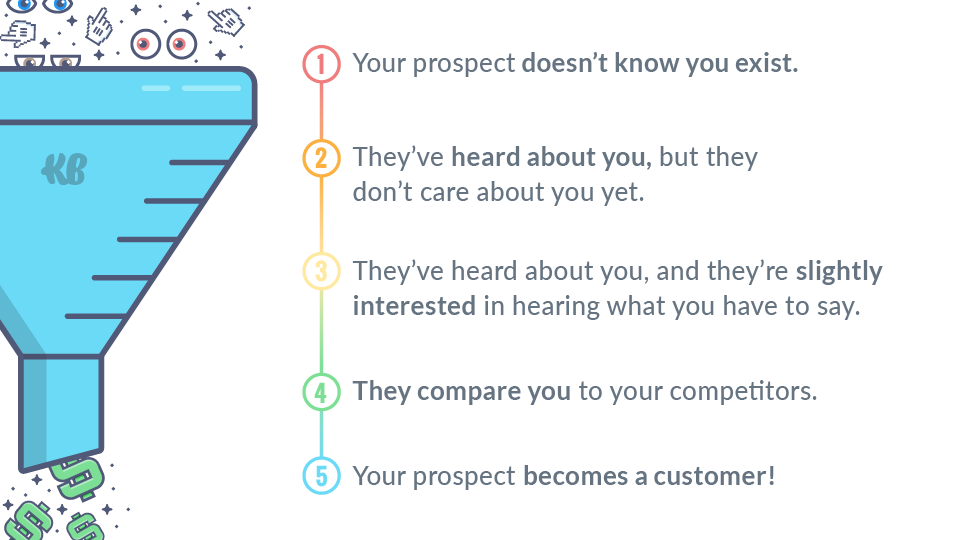
Fit your Google Ads content, offer, and copy to the mindset of a decision-maker at the stage they're in.
Think about the sales cycle in three stages:
Top-of-Funnel
When your prospect is at the top of the funnel, they’re problem-focused. They don't know or care about your company yet; they're researching their problem.
Keywords to include in your ad:
- Broken
- Fix
- Troubleshoot
- Replace
Mid-Funnel
Ok, they know what their problem is now and they start to hunt for a solution.
Keywords to include in your ad:
- Software
- Tool
- Optimize
- Vendor
- Supplier
Bottom-of-Funnel
This is the high-quality audience.They know their problem, they’ve researched solutions, and they’re ready to make a purchase.
Keywords to include in your ad:
- Demo
- Quote
- Proposal
- Pricing
- Trial
- Try now
And there’s one more thing to consider when you put your ads together to maximize the click rate: temperature.
PPC temperature scale
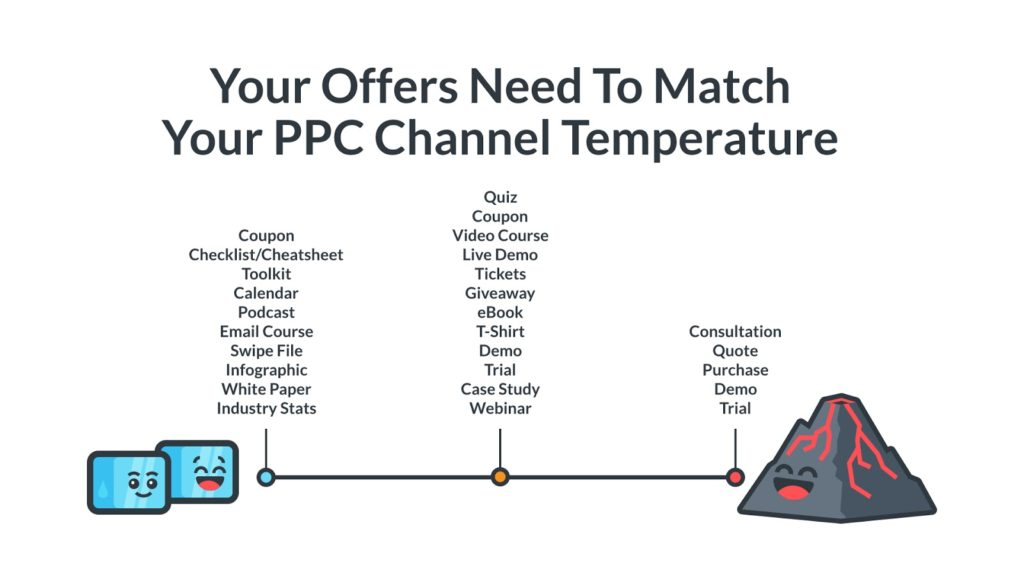
If you throw a Buy My Product CTA in the face of a cold prospect, that will backfire. You will not get that click.
Do this instead:
- Relate to their problem (You’re stuck with X and dealing with Y…)
- How to fix things step by step
- Background on why the problem is happening
Meet them where they are so they get that you get them. Design ads around what's happening in that part of the sales cycle.
Now let’s talk about organization.
2. Stay organized
It's helpful to understand the structure of Google Ads.
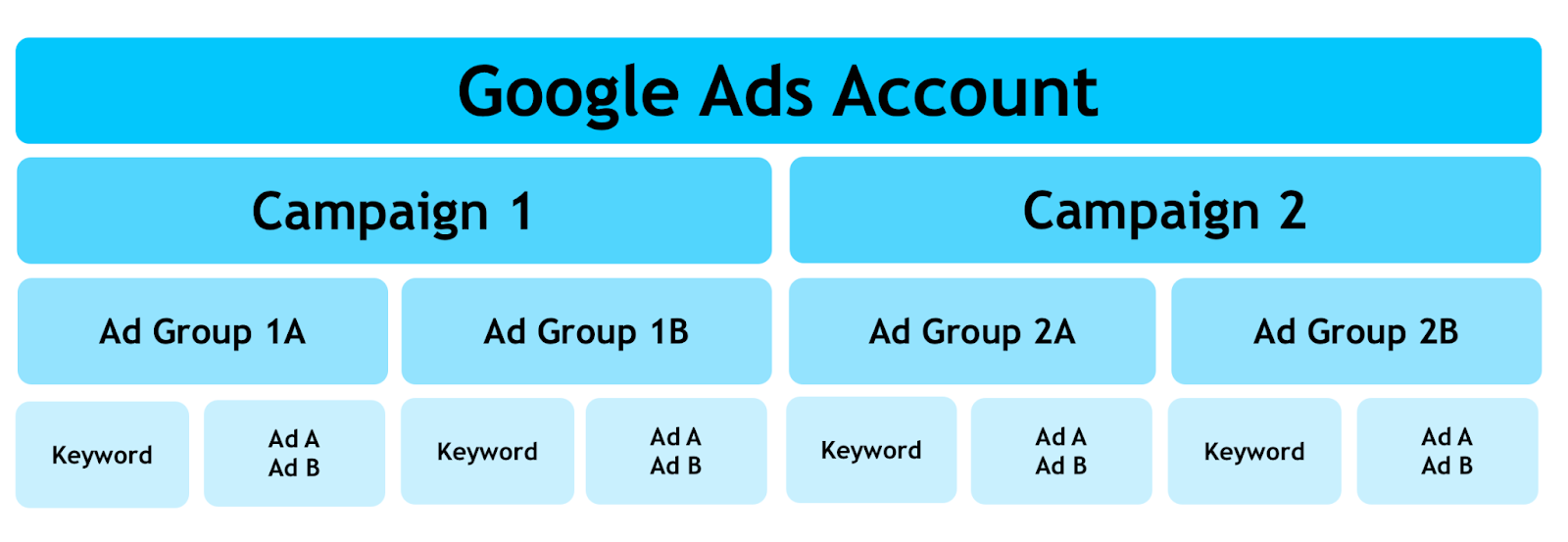
→ Make one Google Ads account per website.
→ Within your account, create one ad campaign per product or launch or service.
→ Under each campaign, organize ad groups by purpose.
→ Keywords and Ads go with an Ad Group.
Organize Ad Groups
If you're running Google Ads like us, you’ll have a lot of Single Keyword Ad Groups (SKAGs), but more on that 👇.
By theme or topic
Another way to organize your Ad Groups is by theme or topic.
Themed Ad Groups are more relevant and targeted. They resonate better with your audience. This approach increases quality scores and boosts conversion rates.
To start, identify the core themes or topics that are relevant to your business.
If you’re a software company, you might have themes like “cloud software,” “cybersecurity,” or “data analytics.”
Create ad groups for each theme, and align the keywords and ad copy within each group to that theme.
Ad group: cloud software
Include keywords like
- Cloud solutions
- Cloud computing
- Cloud storage
Write ad copy that highlights the benefits and features of those cloud software solutions to win higher quality scores and better performance overall.
By funnel
Many B2B Google Ad pros organize groups by funnel stage.
- A mid-funnel group might target branded terms to catch visitors doing research on your business.
- A bottom-of-funnel group might be dedicated to beating the competition.
Organize your Google Ads e to personalize targeting. This puts you in a great spot to run a/b tests or start optimizing.
Keep in mind that each group requires its own
- Budget
- Audience
- Landing page
- Bid amount
3. Extensive keyword research to understand the business and industry
Don’t skip this part.
The single most valuable thing you can do for successful B2B Google Ads is to wear the pants of the industry if you don't know it yet. Go deep on the product or service. Pick specific keywords—don’t get sucked into broad terms because of FOMO.
You need to know exactly what search terms your target audience types into the Google search bar so you’re there waving at them with a helpful smile. They appreciate you being there, so they click. You maximize your ad spend whenconversion rates go up and acquisition costs go down.
HUZZAH 👏
To catch the most qualified searchers, use industry acronyms. For example, pay-per-click will catch some searchers, but PPC is the more likely search term. Know the jargon used for search terms to catch the most qualified searchers.
Group keywords into four main categories:
- Generic: words that talk about your service or product directly (TOFU/MOFU traffic)
- Branded: words that include your brand name (BOFU traffic)
- Competitor: words that mention your competition (BOFU traffic)
- Related: words that talk about your industry and related services or products (TOFU/MOFU traffic)
Use keywords that cover all four categories.
Generic and Related categories will capture your audience at the top and middle of the funnel. Branded and Competitor keywords tend to capture those closer to the bottom of the funnel.
Pro Tip: Brainstorm with your sales team. They talk with all the prospects, so they will know specific pain points your target audience has and what they may be looking for.
Google Keywords Planner
Google Ads builds Google Keyword Planner into the ad platform. Added bonus—it's free.
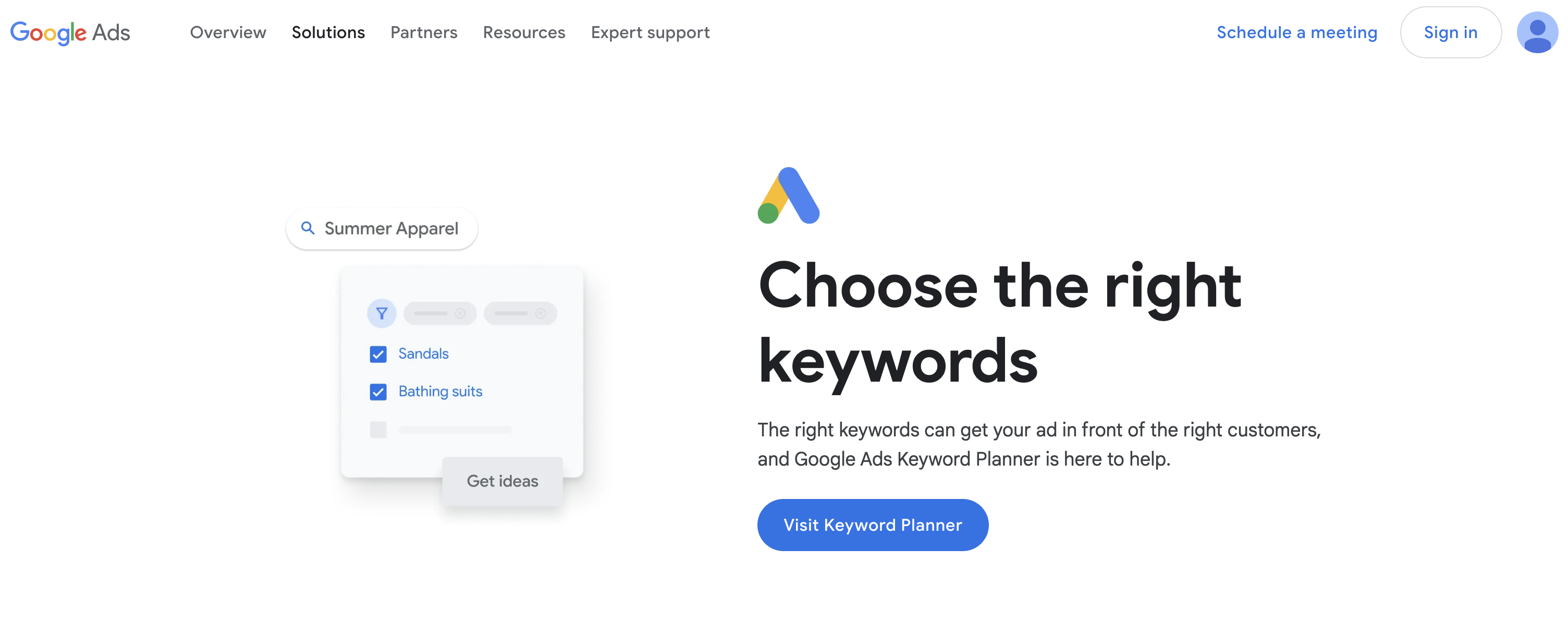
Use Google Keyword Planner to
- Discover new keywords
- Get search volume and forecasts
- See breakdowns by location or device
Once you start selecting keywords, Google Keyword Planner will display
- Average monthly searches
- Competition level
- How much you have to bid to get to the top of page one

Learn how to set it up and take advantage of all the different features with our Google Keyword Planner Guide. We also have 5 other keyword mining tools to help you find PPC gold.
KlientBoost example:
We saved one of our B2B clients $10K+ per month (dropping from $25K+ per month to $12K) and netted more qualified leads) with this B2B Google Ads keyword strategy.
Strategy: Ditch out-of-market keywords to eliminate wasted spend
Out-market keywords:
- They’re relevant to your audience (good)
- They're usually high-volume (good)
- But there's no purchase intent (BAD)
No purchase intent means they are still googling starting-stage research stuff like
- "What is SaaS?"
- "Benefits of digital transformation"
- “Types of cloud software”
Don’t bid on keywords because you’re afraid you’ll miss out on that volume. FOMO is a black hole for B2B Google Ads budgets because it’s too hard to convert a prospect who hasn’t come “in-market” yet.
There is no perfect ad that will convince them to buy. No landing page, lead magnet, or nurture sequence either.
It's not how B2B buying works. Instead:
Use In-Market Keywords
In-market keywords
- Are hyper-specific to category & capabilities
- Usually have a much lower volume
- Have obvious purchase intent
In-market keywords fall into two buckets: category keywords and capability keywords.
Category keywords
These describe the what for the who
Examples include:
- "HR software for SaaS companies"
- "Project management tool for B2B"
- "CRM for enterprise businesses"
Capability keywords:
These describe the what and the with (focus on features, functions, or use cases).
Examples include:
- “HR software with payroll integration”
- “Project management tool with Gantt charts”
- “CRM with lead scoring and segmentation”
If someone clicks on this keyword, there is clear intent to buy. The user is looking for a solution to a pressing problem and is willing to pay to solve it.
As a result, these keywords have the highest conversion rates to pipeline and revenue and produce the most ROI.
Takeaway: Allocate the majority (40%–60%—and push more if there’s volume) of your Google Ads budget to in-market keywords. Don’t cast a wide net with Google Ads keywords—that’s a guaranteed way to waste valuable budget.
Focus on in-market category and capability keywords to maximize pipeline, revenue, and ROI from Google Ads.
4. Targeted audiences
Audiences don’t have to be a shot in the dark, especially when it comes to B2B. Take a look at some of your organic visitors to figure out which businesses are already scoping you out using the Internet Protocol (IP) address.
An IP address is a numerical label assigned to each device connected to a computer network that uses the internet. Think of it like your home address. It's where you send mail to and from—a unique identifier of your location. Every IP address is registered to an individual or company. Most mid-large-sized companies have their own IP address, which is good news for you.
Unfortunately, Google Analytics has blocked the ability to view IP addresses. Fortunately, there are a ton of tools that identify who's viewing your website, including
There are also options such as Clearbit, ZoomInfo, and Lusha that identify a visitor’s company and enrich the data even further with information such as emails or phone numbers.
Once you know which businesses have visited your website, add the User Domain of the IP addresses as a custom audience within your Google Ads. For example, if you target amazon.com, you can target Amazon employees who access the internet with an IP address from that domain.
Pro Tip: This technique lets you exclude IP addresses, too. Try excluding IP addresses that come from your competitors so you don’t waste money on them.
5. Negative keywords
List the keywords you don’t want.
When you don’t make a negative keyword list, you waste ad spend.
With most keywords, there are related words that have a totally different intent. The most common situation where negative keywords come into play is with job seekers.
If your goal is to sell data security software, you don't want people who are searching for “data security jobs.” It's a no-brainer to include “job(s)” in your list of negative keywords.
If you're not targeting job-seekers, consider adding the following keywords to your negative list:
- Intern
- Career
- Resume
- Employer
- Intern
- Part-time
- Full-time
- Hiring
Pro Tip: Consider misspellings, homonyms (words that are spelled the same but have a different meaning), and accidental pop culture references when compiling your negative keyword list.
6. SKAGs
We talked about how to structure your Google Ads Account already, but refresher:
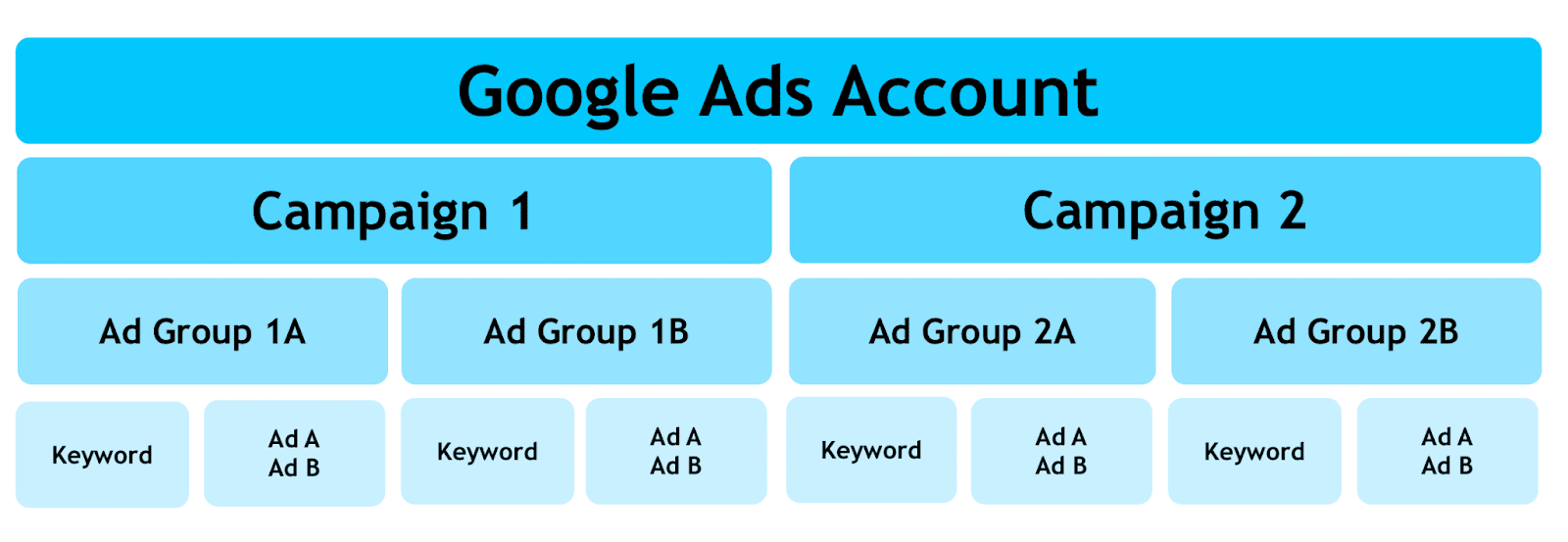
Now let’s talk about Ad Groups that have one keyword in them.
As the name implies, that’s what Single Keyword Ad Groups (SKAG) are.
The SKAG approach is one of the fastest ways to get more clicks per impression (better click-through rates), better quality scores, and, most importantly, more money.
SKAGs give you control of your account to achieve higher performance.
By pairing your keywords into their own unique Ad Groups, you make sure the keywords you bid on match the search terms you pay for.
If you don't take care of this, you end up with something we call The Iceberg Effect. Learn how to use SKAGs and watch your cost-per-click (CPC) go down.
7. Optimized ad copy
Sometimes, it’s easier to write a blog article than an ad. With such a small amount of real estate, every letter matters. The words you use have a profound impact on the success of your Google Ads.
Follow these 7 best practices to optimize your ad copy.
- Speak to pain points: Before pushing the product or service, acknowledge the problem. This tells your prospect you understand them—empathy is huge.
- Personalize copy to the funnel: Different funnel stage, different problems, different solutions. Put yourself in their shoes and answer the question they have now (which is different from the question they’ll have later)..
- Be specific and use numbers when possible. Science backs it. People like specific numbers. Let them know it's a “14-day trial,” or that you have “16 solutions” to their problem, or “791 people signed up for the webinar.”
- Keep it simple. You don’t have room for complex, multi-syllable words, or fluffy adverbs.So don’t say, “Learn more about data security in our newest report.” Say “Free data security report.”
- Stand out from the crowd: Pay attention to competitor ads. Their ads will be next to yours. Make sure you're not saying the same thing.
- Use social proof: Credibility comes from awards and the number of downloads, subscribers, and logos who love your products and services. Share that..
- Use extensions. They help the person staring at your ad make their next move, whether it's a call extension, links to relevant pages on your website, or directions.
8. Optimized landing page
If your ad wins a click, make sure the page the user sees is fantastic.
We’ve designed a few thousand landing pages that won hearts, minds, and wallets for clients.
Here are 40 stealable landing page examples, and below are a handful of best practices we know every good landing page needs:
- Ditch the top navigation. Keep visitors focused on the reason you brought them there.
- One clear call-to-action (CTA): Ok, fine, sometimes two work. But focus on one clear, preferred action. Place it above the fold and at the bottom of the page—minimum.
- Keep it relevant: Exactly match the landing page to the ad they clicked on to get there. If the ad offers a free report and you send them to a service page, you’ll get a bounce (which hurts) and a potential prospect who thinks less of your brand (which hurts more). Final blow: your ad's quality score will tank..
- Strong copy: There’s no way around this. Use GenAI to help if you struggle with copy. Feed an AI engine ad examples that you like. But add your brand’s voice because AI still sucks at that (even when you coach it). Make sure your headline and subheader communicate your Unique Value Proposition (UVP), too.
- Hero image and visuals: We're not saying they need to be fancy but, come on, no one wants to read a page full of only text. Bonus points for visuals that convey loads of information clearly and quickly for a better user experience.
- Benefits and features: You’re trying to inspire action after all, so don't forget to communicate the why (benefits) and the how (features).
- Social proof: Let your fans speak on your behalf. Embed a customer testimonial video on the page or splash the stats—like impact or number of clients—to add credibility. Share user-generated content (UGC) if you have it.
- Journey awareness: A good landing page tailors the CTA, copy, and visuals to where visitors are in the sales funnel (the same way the ad does). Don't get too pushy for a sale before they learn about who you are and what you do.

9. Measure and optimize
PPC is not something you set and forget (unless you love money bonfires 🤑🔥)
The best PPC campaign fine-tunes every detail, from the headline and landing page to the specific offer. The fine-tuning happens when you a/b test.
And without the right metrics, you can't identify what's working or what's not.
Be sure to connect your Google Analytics to Google Ads.
Make sure you have all the conversion points sent up as goals within Google Analytics. Conversions are your most coveted action, so you'll want all the info you can get.
Here's 21 huge insights that you’ll get when you connect Google Analytics to your Google Ads properly.
Believe it or not, our team checks in on ads daily. Managing ads is extremely time-consuming, but we're all about working smarter, not harder. These time-saving tips maximize the value of your minutes, and the return on every ad dollar spent.
10. Retargeting
96% of visitors who visit your website aren't ready to buy. At least not yet.
The goal is to get them to come back. And the strategy to make that happen is called retargeting.
With remarketing, you
- Stay top of mind even as prospects shop around or check out competitors
- Continue to provide value and thought leadership to those who aren't ready to purchase
- Get a second chance at converting lost leads with convincing social proof or a good deal
Especially because you're dealing with the B2B sales cycle, you can't expect visitors to convert right away. You also can't assume they'll remember you months later (or even a week later). Don't leave it up to fate, or you'll lose qualified leads. Make sure you're there to provide whatever they need every step of the way.
Google Ads makes it easy to retarget visitors using Remarketing Lists For Search Ads (RSLAs). We've put together a 12-point guide (opens in a new tab) to setting them up (and capturing lost conversions). By employing a RLSA campaign for an award-winning provider of friendly, peppy and efficient virtual receptionists, we saw a 125% drop in CPA.

See the positive results we’ve had with five other clients.
Top 3 B2B Google Ads mistakes
These are the 3 most expensive mistakes B2B marketers make:
- Too many non-search campaigns
- Low-intent keyword strategy
- Inefficient bidding
Focus on Search Ad campaigns
Campaigns like Pmax, Demand Gen, YouTube, and Display can work. But they’re not the best at capturing demand, so your ROI will suffer. Search campaigns are where you'll find the most in-market prospects. Put your budget there.
Low-intent keyword strategy
Many B2Bs target keywords they think their ICP might search.
80%+ are usually inefficient informational keywords—the client is just beginning the buyer journey—that don't signal buying intent. It's almost impossible to convert an out-market prospect.
Target keywords in-market ICPs would search AND that signal buying intent, too.
Blend category and capability keywords.
Cut anything else.
Inefficient bidding
Which of these bidding strategies do you use?
- Target impression share
- Max click
- tCPA
- tROAS
- Max conversions
Target impression share and Max click
Target impression share or max click bid strategies typically drive poorer quality traffic. They lead to no leads or low-quality leads. Avoid them for anything except brand and (sometimes) competitor campaigns.
tCPS and tROAS
tCPA and tROAS work well if you have high lead and traffic volume—but most B2Bs don't.
Max conversions
Max conversions with an offline conversion as your primary conversion action works best. The further downstream you can set your primary conversion action, the better.
We currently use MQL for KlientBoost’s ad accounts. But MQL for us includes intent-to-buy.
Google Ads' superpower is capturing demand
The most efficient B2Bs:
→ Limit non-search campaigns
→ Focus on high-intent keywords
→ Optimize bids for pipeline
That's how to drive a high-ROI pipeline from Google Ads in 2025.
B2B Google Ads campaigns in a nutshell
B2B marketers mistakenly throw their money out the Google window and then write off PPC because they get bad results.
We’ve used Google Ads to make game-changing improvements for businesses. We understand why Google hits hundreds of $billions in revenue.
Because it works.
We're confident enough to say that we guarantee positive results. Hit us up if you feel overwhelmed and need impressive results right from the get-go. If you're down to take it on yourself, you check out our Google Ads course. This is the course we use to train our team internally.

If you found this article helpful, here's some other can't-miss content you'll want to see:
- 16 High-ROI Google Ads Optimization Tips (checklist)
- How To Set Pricing & Save On Google Ads Costs
- 10 Must-Try Ad Copy Hacks We Tested On Over 100 Clients
- 28 Genius Google Ads Filters For Better Performance
- Google Ads Tips: 7 Ways to Improve Your Performance
Let us know how it works out. We love to see it!
FAQ
When should I expect results from B2B Google Ads?
Expect initial data within 30-60 days, but meaningful results typically emerge around 3-6 months. B2B sales cycles are longer, so patience and consistent optimization are crucial for success.
Can small businesses compete with large enterprises in Google Ads?
Absolutely. Smart targeting, niche keyword selection, and hyper-relevant ad copy can help small businesses compete effectively. Focus on your unique value proposition and leverage granular audience targeting to maximize your B2B Google Ads performance
